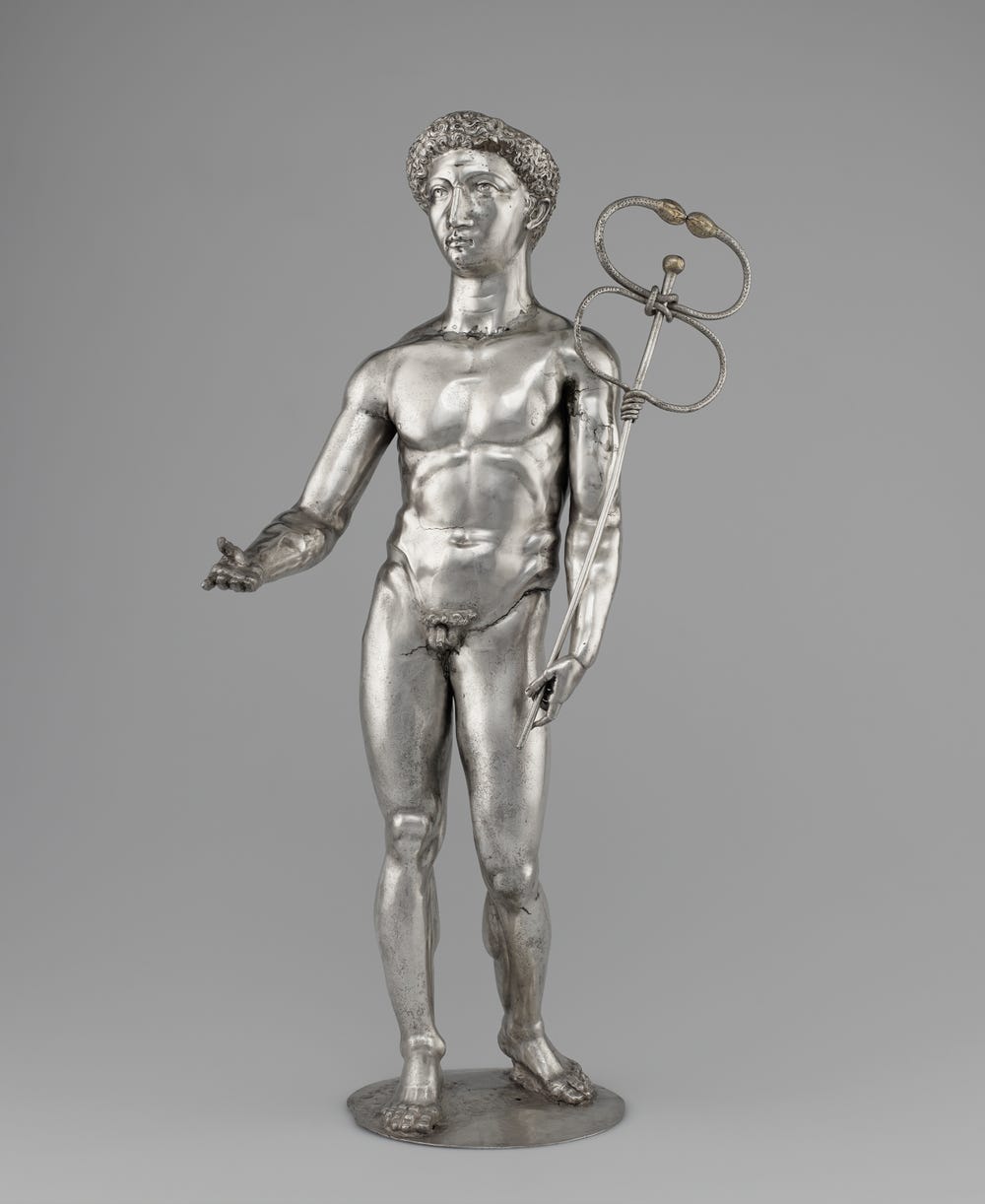Ancient Luxury and the Roman Silver Treasure from Berthouville
Sep 17, 2015
Mercury, Roman, AD 175–225. Silver and gold. Bibliothèque nationale de France, Département des Monnaies, médailles et antiques, Paris.
Legion of Honor \ September 19, 2015–January 10, 2016
SAN FRANCISCO—The Fine Arts Museums of San Francisco are pleased to announce Ancient Luxury and the Roman Silver Treasure from Berthouville, opening at the Legion of Honor on September 19, 2015. More than 160 luxury objects including silver vessels and sculptures, cameos, intaglios, hardstone vessels, gold coins, jewelry, bronze figurines, a mosaic, and four Late Antique missoria (silver platters) will be on loan from the Département des Monnaies, médailles et antiques (also known as the Cabinet des médailles) of the Bibliothèque nationale de France, Paris.
“The Cabinet is one of the finest repositories of ancient luxury arts in the world, and we are thrilled to present some of the most magnificent remnants of antiquity from its collection,” said Renée Dreyfus, curator in charge of ancient art and interpretation at the Fine Arts Museums of San Francisco. “The Berthouville Treasure is a dazzling hoard of Roman silver-gilt vessels and statuettes that recently was held in the Getty Villa conservation lab, where over four years the pieces were meticulously conserved, restored, cleaned, and studied. The remainder of the exhibition is filled with other precious Roman works from the ancient period and Late Antiquity.”
The Berthouville Treasure, containing gilded and profusely ornamented pieces that are recognized today as among the finest surviving ancient Roman silver objects, was discovered in 1830 by a French farmer while plowing his field near the village of Berthouville. This cache of approximately ninety gilt-silver objects dating to the first to third centuries AD was intentionally buried in antiquity, and miraculously escaped being found and melted down during the intervening centuries. The treasure was acquired soon after its discovery by the Cabinet des médailles, and was on view in Paris until 2010, when it traveled to the Getty Villa.
The new conservation revealed previously unknown details, gilding, and inscriptions—some indicating that these silver objects were dedicated to the god Mercury by both men and women, and by former slaves and freeborn alike. The objects are adorned with centaurs, cupids, and other Bacchic imagery in addition to familiar mythological and historic scenes like those depicting the Trojan War. The additional objects on loan from the Bibliothèque nationale conveyed luxury and high status in antiquity. The exhibition demonstrates the technical and artistic skill of artists and craftsmen at the height of the Roman Empire and into Late Antiquity.
legionofhonor.org \ @LegionofHonor
Visiting \ Legion of Honor
Lincoln Park, 34th Avenue & Clement Street, San Francisco, CA 94121
Open 9:30 a.m.–5:15 p.m. Tuesdays–Sundays; open select holidays; closed most Mondays.
Tickets
Information on purchasing tickets, groups of 15 or more, and membership.
Catalogue
This sumptuously illustrated volume presents the highlights of the Berthouville Treasure and other ancient luxury arts from the holdings of the Département des Monnaies, médailles et antiques—including precious gems, jewelry, gold coins, and bronze figurines—and contextualizes them in a series of elucidating essays. Hardcover, 224 pages. Purchase here.
Exhibition Organization
This exhibition is organized by the J. Paul Getty Museum in collaboration with the Bibliothèque nationale de France, Département des Monnaies, médailles et antiques, Paris. Benefactor’s Circle: Ancient Art Council
About the Fine Arts Museums of San Francisco
The Fine Arts Museums of San Francisco, comprising the de Young in Golden Gate Park and the Legion of Honor in Lincoln Park, are the largest public arts institution in San Francisco.
The Legion of Honor was inspired by the French pavilion, a replica of the Palais de la Légion d’Honneur in Paris, at San Francisco’s Panama-Pacific International Exposition of 1915. The museum opened in 1924 in the Beaux Arts–style building designed by George Applegarth on a bluff overlooking the Golden Gate. Its holdings span 4,000 years and include European painting, sculpture and decorative arts; ancient art from the Mediterranean basin; and the largest collection of works on paper in the American West.
The de Young originated from the 1894 California Midwinter International Exposition and was established as the Memorial Museum. Thirty years later, it was renamed in honor of Michael H. de Young, a longtime champion of the museum. The present copper-clad landmark building, designed by Herzog and de Meuron, opened in October 2005. It showcases the institution’s significant collections of American painting, sculpture and decorative arts from the seventeenth to the twenty-first centuries; art from Africa, Oceania and the Americas; costume and textile arts; and international modern and contemporary art.
Media Contacts
Erin Garcia \ egarcia@famsf.org \ 415.750.8904
Miriam Newcomer \ mnewcomer@famsf.org \ 415.750.3554
